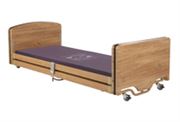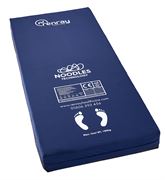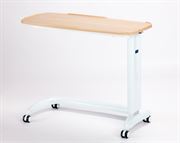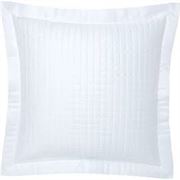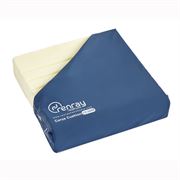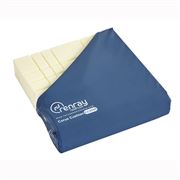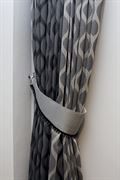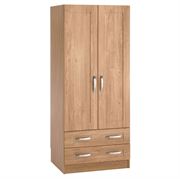We know the need for a contrast between surfaces, furniture and objects is important, as contrast provides the definition required for residents with visual impairments to navigate their space due to dementia affecting how well someone can tell the difference between colours.
People with dementia require an internal and external environment that is safe and easy to move around in if they are to continue to pursue their way of life and make the most of their abilities.
It also might help to avoid colours that can be mistaken for real things, such as green (grass) or blue (water). And avoid using high gloss finishes or floor surfaces which highlight reflections, use a matte finish where possible, as a person with dementia may perceive these surfaces as wet or as a mirror.
High contrast is defined as an LRV contrast value of 30 or higher. In your nursing home, the walls and floors should have high contrast since it assists with deteriorating depth perception. Simply put, this means that it aids locals in determining where one surface stops and another begins. In light of this, it is recommended that furniture materials and linens contrast with the floor to make them equally visible.
A flat surface or no depth is perceived when the LRV contrast value is less than 10. This is ideal for areas like bedroom floors and hallway floors where you want your seniors to be able to move about on their own.
Light Reflectance Value
Light Reflectance Value (LRV), is a measure of the percentage of visible and usable light that is reflected from a surface when illuminated by a light source. It tells you how much light a colour reflects and conversely how much it absorbs. LRV runs on a scale from 0% to 100%. Zero is assumed to be absolute black and 100% a perfectly reflective white. LRV’s are particularly important when designing interiors that are suitable for the disabled and for those who are visually impaired.
Light Reflective Values (LRV) are an important aspect of interior design, especially in care homes, where they can play a critical role in promoting the well-being of residents. LRV refers to the measurement of how much light is reflected off of a surface and how much is absorbed, and it is an important factor in creating a warm and welcoming environment in care homes.
One of the primary reasons that LRV is so important in care homes is that it can affect the mood and well-being of residents. High LRV surfaces, such as light-colored walls and furniture, can help create a bright and airy atmosphere, promoting feelings of positivity and happiness. On the other hand, low LRV surfaces, such as dark colours or matte finishes, can create a more sombre and gloomier atmosphere, affecting residents’ moods and well-being.
LRV is also important in care homes because it can help residents with low vision or visual impairments navigate their environment more easily. High LRV surfaces reflect more light, making it easier for residents to see and move around the care home, reducing the risk of accidents or falls.
Another important aspect of LRV in care homes is that it can affect the overall energy efficiency of the building. High LRV surfaces can help to reflect natural light into the care home, reducing the need for artificial lighting and cutting energy costs.
In conclusion, Light Reflective Values (LRV) are an important aspect of interior design in care homes, as they can play a crucial role in promoting the well-being and safety of residents. By considering LRV when choosing surfaces and colours for care homes, designers and care providers can help create a warm, welcoming, and energy-efficient environment for residents.
When identifying differences between adjacent colours, differences in the nature of the colour or its intensity are usually sufficient for people with good vision. For most partially sighted people however, differences in colour alone are not sufficient to determine visual contrast and they are more reliant on distinguishing visual differences by variations in the light reflectance value (LRV) of adjacent colours.
Current guidance and Code of Practice BS 8300:2009 state that adequate visual contrast is provided if the LRV of the contrasting areas differ by at least 30 points.
Considered use of colour can significantly improve a visually impaired person’s way-finding ability. It can create pathways, identify obstacles, and define volume and space helping to make the physical environment safer and easier to use.
Most fabrics and vinyls that we offer for upholstery have been tested for their LRV value in order to make the design process easier and are available on swatch cards that your account manager will provide to aid you with product selection.
Renray wood finishes also have been tested for their LRV value and are available via your account manager, again to aid you with product selection.
If you have carpet or safety flooring fitted, the manufacturer can provide you with LRV values, as they will also have been tested.
Paint and wallpaper. Paint has LRV values that can be looked up online. Wallpaper is a different matter, wallpaper bought from a trade supplier may have LRV values but a retail wallpaper stockist probably will not.
Lighting
Most people with dementia, and older people in general, benefit from better lighting in their care home – it can help to avoid confusion and reduce the risk of falls. Try to reduce glare, shadows, and reflections. Lighting should be bright, even and natural (as much as possible). So striking the balance and thinking through the lighting as part of the overall design plan will ensure you get it right for residents, visitors and staff.
Good Care Home Design
The way a care home is designed and laid out can have a big impact on someone with dementia. Symptoms of memory loss, confusion and difficulty learning new things means that someone with dementia may forget where they are, where things are and how things work. Renray furniture and design advice can provide your care home with the modern, stable, fit for purpose furniture pieces and furnishings you will use to complement your room schemes and lift the look and feel of your home whilst making it a suitable collection for your dementia residents.
Designed with you in mind….


